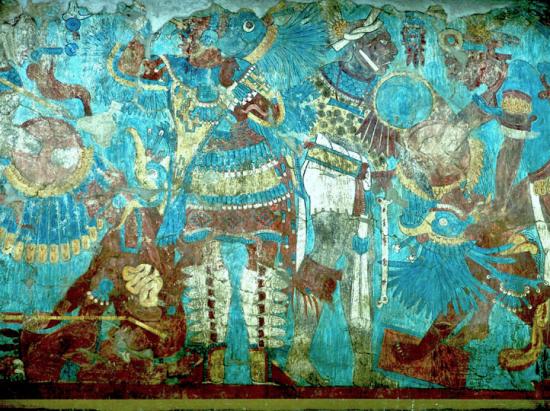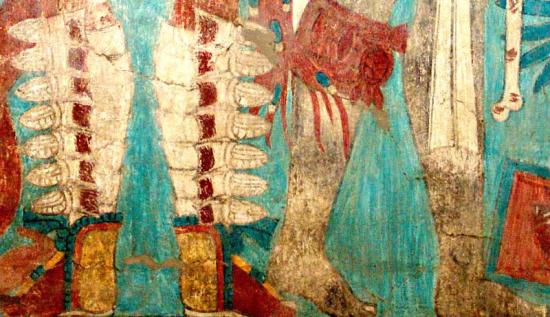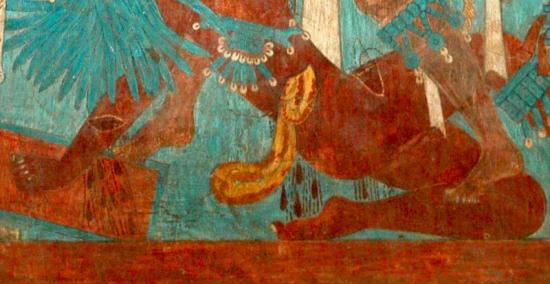TEN ARTISTS PAINTED THE OLMECA-XICALANCA BATTLE MURAL
http://www.pasthorizonspr.com/index.php/archives/07/2014/ten-artists-painted-the-olmeca-xicalanca-battle-mural
Photos : INAH
AL MENOS 10 PINTORES, LOS CREADORES DEL MURAL LA BATALLA
http://www.inah.gob.mx/boletines/14-hallazgos/7244-al-menos-10-pintores-los-creadores-del-mural-la-batalla
The remarkable 1300 year old mural The Battle, found at the archaeological site of Cacaxtla in Tlaxcala (East-Central Mexico), has been subjected to comparative analysis by the researcher Claudia Brittenham, who managed to identify ten separate painting styles.
The specialist from the Department of Art History at the University of Chicago, carried out a detailed study in situ using a comparative approach that catalogued and examined the small details that often get repeated by a specific individual allowing her to see the individuality of each artist.
“We found differences in the shape of the hands, feet, faces and feathers. Each artist has a very distinctive way of painting and a pattern was noticeable in a group of figures.”
She explained that within the mural it was possible to characterise and highlight the individual who drew big feet, while another had a style that included very long fingers, and so on.

The Battle. Image: Mauricio Marat INAH
Working at an equal level
Brittenham said that unlike the European school, where a workshop master would responsible for the entire preliminary design, The Battle had all painters working at an equal level. “Everyone was in charge of an area of the wall and was responsible for his/her painting from the first sketch to the finished line.”
The Art historian added that this style required an effort to coordinate transitions between personal styles along the whole work. “There is some evidence of planning the composition: and who worked on the various sections, with the most gifted painters working on the central part.”
There may have been other helpers to prepare the pigments and the walls, she said.
A cosmopolitan work
Brittenham said that the mural speaks of a cosmopolitanism of theme, style and painting technique. “These paintings reveal a high knowledge of other artistic traditions of Mesoamerica, from the Zapotec and Maya to the Gulf Coast. But they also reveal a legacy of Teotihuacan tradition. “
The pigments that were used in the work, resemble those of the Maya area, but use of the rubber cactus as a binding agent and the technique of painting on a nearly dry and highly textured surface is connected to the tradition of the Zapotec.
“It is a synthesis perfectly adapted to the needs of Cacaxtla, and shows us that the Mesoamerican world was interconnected, like ours.” Brittenham commented.

Differences in the shape of the hands, feet, faces and feathers show that each artist had a distinctive painting style. Image: Melitón Tapia INAH.
Fellow researcher Diana Magaloni identified the type of pigments that were developed for Cacaxtla murals. “They are mostly locally sourced minerals, lime for white, charcoal black, to red haematite, goethite for yellow. Blue is the famous Maya blue, a clay called palygorskite, dyed with indigo.
“Sometimes, mixtures of red and black pigments were used to achieve different skin tones, and three shades of blue: light, medium and dark-to create stunning effects. With this restricted palette of colours, as opposed to that used at Bonampak by the Maya, the painters at Cacaxtla were still able to create stunning and powerful naturalistic work.”

Detail of a horrific stomach wound. Image: Melitón Tapia INAH.
The battle represented in the mural took place between the years 650 and 700 AD, by warriors of an Olmeca-Xicalanca alliance. The winners are mainly wearing jaguar skins and are shown attacking with spears, obsidian knives and throw darts. The losers carry bird feather headdresses and jade jewellery, appearing wounded and maimed; however, recent research by María Teresa Uriarte controversially argues that it is not a depiction of a real confrontation, but a sacrifice in honour of the god of corn.